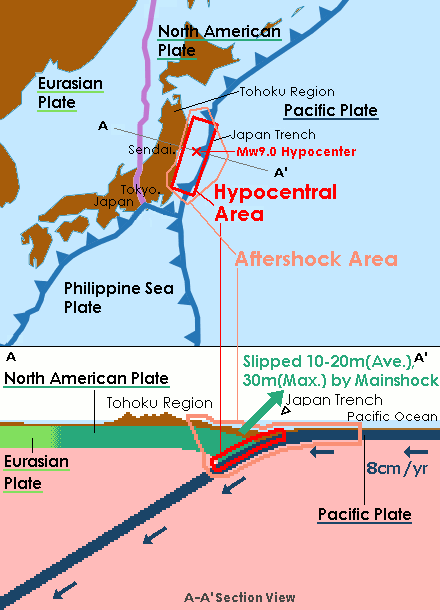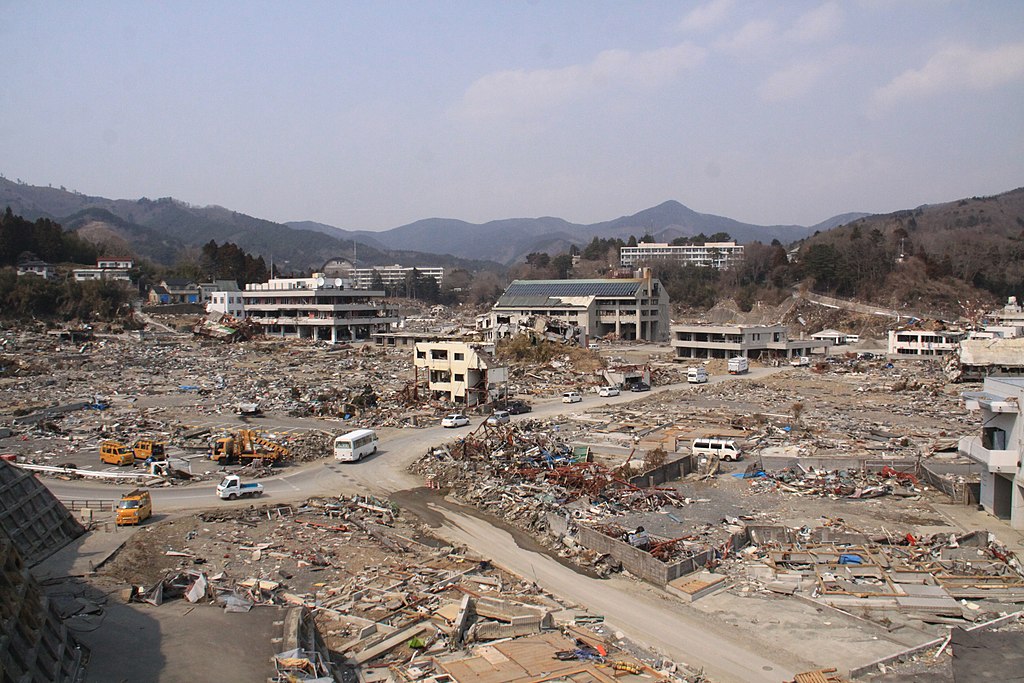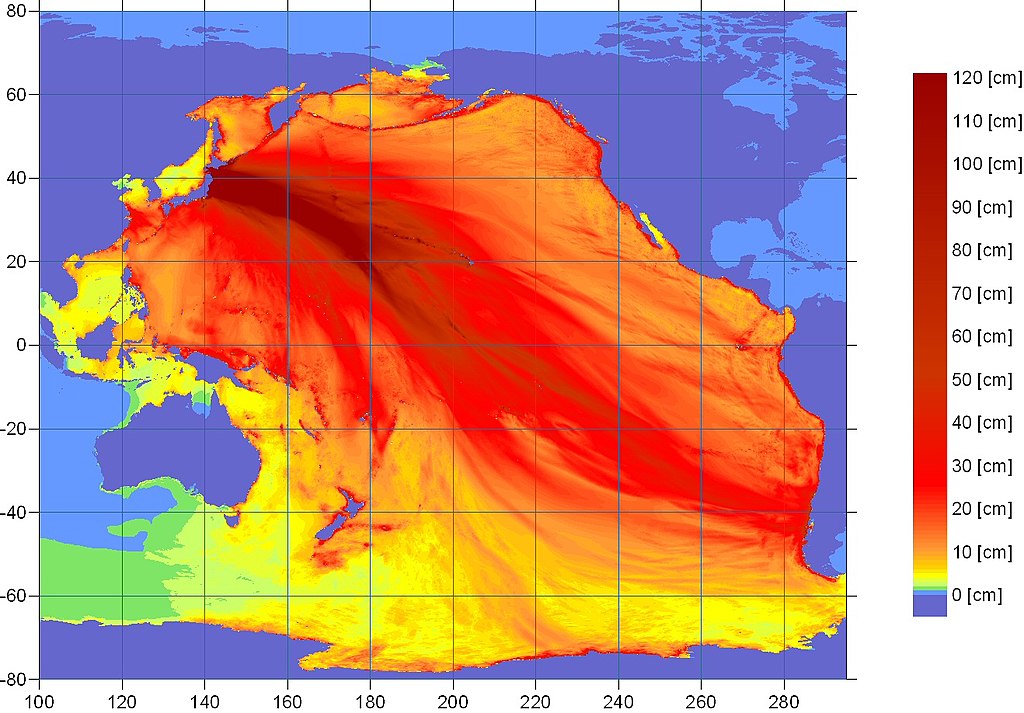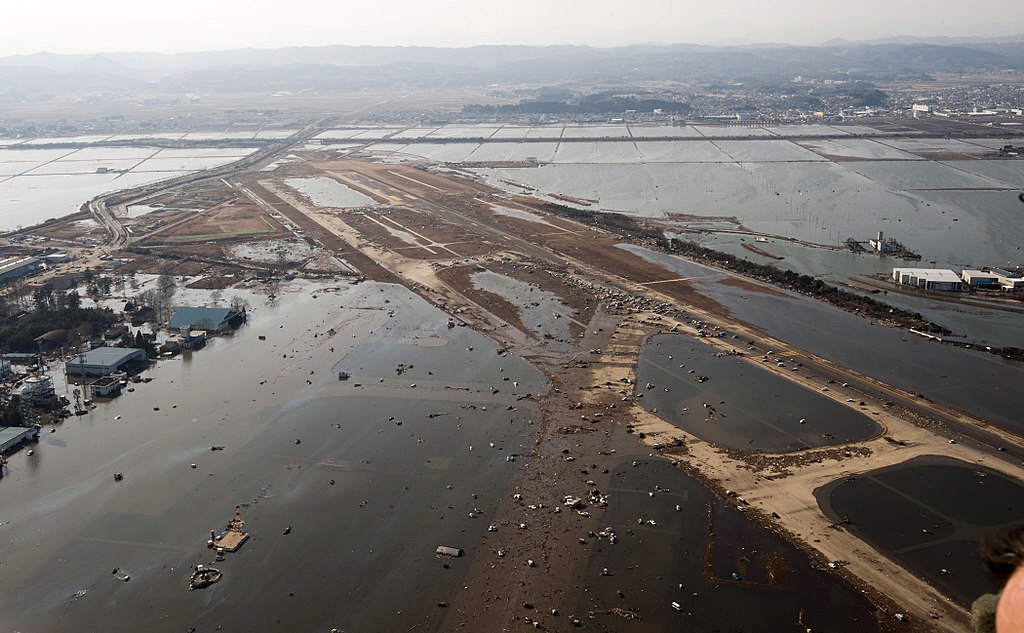On March 11, 2011, at 3:46 p.m. local time, a magnitude 9.1 earthquake occured off the northeastern coast of Honshu, the largest island of Japan. This was the most powerful earthquake ever recorded in Japan, and one of the strongest ones in the world in the past few centuries. The shock and the tsunami that followed it caused an immense amount of destruction throughout northern Japan, with around 20,000 deaths and hundreds of billions of dollars of damages. This event was described by then Prime Minister of Japan Naoto Kan as the greatest crisis faced by Japan since World War II.
This megathrust earthquake happened on an heavily seismic area, where the Pacific Plate is subducting under Honshu moving by around 8 or 9 cm every year. As this motion occurs, a large amount of energy builds up until the accumulated stress causes a rupture event along the fault line. The rupture in the fault that caused the unusually strong 2011 earthquake had a length of 500 km and a width of 200 km, according to the Japanese Meteorological Agency. The same mechanism caused other large earthquakes in the same region, most notably the 1896 and 1933 events, which had a magnitude of 8.5 and 8.4 respectively.
Mechanism of 2011 Japan earthquake (Pekachu, Wikimedia Commons, CC BY-SA 3.0).
The 2011 earthquake lasted six minutes and was followed by thousands of aftershocks, some of which had a magnitude over 7.0, with the strongest one reaching a magnitude of 7.9. The main shock was registered as having an intensity of 7 on the Japan Meteorological Agency seismic intensity scale, the highest possible level. With such a powerful intensity, people are thrown off by the shock and can’t stand or even move, most buildings collapse, even highly earthquake-resistent ones, roads and bridges are damaged, trees fall, and the ground is distorted to the point that large cracks and fissures can open.
The energy of the seismic waves has been estimated to be around 1.9×1017 J, almost double the amount released with the 2004 Indian Ocean earthquake, which had a similar magnitude. The peak ground acceleration, a measure of the shaking caused by an earthquake, was calculated to be 2.99 g, one of the highest ever recorded. For comparison, the devastating 2023 Turkey-Syria earthquake only had a peak ground acceleration of 1.69 g.
The shock was strong enough to cause various topographical and geophysical changes not only in Japan, but worldwide. Some portions of Honshu moved by up to 2.4 meters to the east, while the entire Pacific Plate shifted by tens of meters, and the entire northeastern coast of Japan was lowered by about 60 cm. Soil liquefaction and land subsidence was observed throughout all of northern Japan, damaging many buildings. Due to the earthquake, the rotational axis of the Earth moved by an amount estimated to be between 10 and 25 cm. This caused an increase in the speed of the Earth’s rotation, shortening the length of the day by 1.8 microseconds.
Damage in Onagawa, Miyagi Prefecture, one of the worst-hit towns in the 2011 Japan earthquake and tsunami (ChiefHira, Wikimedia Commons, CC BY-SA 3.0).
Despite all of this, most of the victims and damages were not caused by the earthquake, but by the tsunami that followed the initial shock. As the earthquake caused the seabed to move up by several meters, a huge amount of water was displaced, resulting in a large tsunami. Minutes after the earthquake, the waves started hitting the Japanese coast, jumping over the seawalls and wiping out entire villages and claiming thousands of lives. Most of the coast experienced waves of over 4 meters. The tallest waves were estimated at a height of 38.9 meters near Miyako, one of the towns which suffered the most damages, but other estimates suggest that the tsunami could have reached a height of over 40 meters on other points along the same coast. The tsunami warning that was issued just after the earthquake saved many lives, but the height of the waves was expected to be much lower, and some people died thinking they were high enough to be safe.
The tsunami wave crossed the entire Pacific Ocean, causing damages in the Philippines, Indonesia, Papua New Guinea, Hawaii, and the western coast of Canada and the United States. Waves up to 3 meters tall reached the Galápagos Islands and Chile, damaging various buildings, and Antarctica, where some icebergs broke off the ice shelf. Unusual waves were observed even in the Norwegian fjords, on the opposite side of the world from Japan.
Map of the energy released by the tsunami in the Pacific Ocean.
The National Police Agency of Japan reported over 120,000 “totally collapsed” buildings and almost a million “half collapsed” or “partially damaged” structures. Many ports along the eastern coast of Japan were damaged, and some remained closed for weeks or even months, while the Sendai airport, located near the coastline, was completely flooded. Several road and railway lines were also damaged, but the early earthquake warning system that stopped all high-speed trains immediately after the initial shock prevented derailments. However, it took days or even weeks to resume train services to some of the most affected areas. Hundreds of cultural properties and monuments were also damaged, including some of the Shrines and Temples of Nikkō, a UNESCO World Heritage Site.
Flooded Sendai airport after the tsunami.
When the earthquake hit, various power plants were shut down and the electrical grid was heavily damaged, causing several blackouts and leaving millions of people without electricity. Also, many dams were damaged, with at least one completely collapsing. Most notably, the Fukushima Daiichi Nuclear Power Plant was hit by the tsunami waves, causing the most severe nuclear accident since the Chernobyl disaster in 1986. The 14-meter-high waves swept over the seawalls, flooding the power plant and leading to a failure of the generators and three nuclear meltdowns, with the release of radioactive material. In the following days, over 200,000 residents living in a radius of 20 km around the power plant were evacuated. The radioactive waste polluted the surrounding waters and, in turn, many food prodcuts in Japan, while the ocean currents spread the contaminated material. As of 2024, the effects of the disaster on the health of the locals is still being assessed.
The final figures by the Japanese authorities estimate a total of 19,759 victims and 2,553 people missing. Over 90% of these deaths were caused by the tsunami. In addition to the earthquake and the tsunami, low temperatures and snowfall on the day of the shock and during the following weeks hindered the rescue efforts. The damage caused by the earthquake, tsunami, and nuclear accident made this event one the costliest natural disaster in history, with estimates ranging between 200 billion and 360 billion dollars. The economic impact of the disaster resulted in a drop of Japan’s GDP, with many factories being closed and farmlands rendered unusable, bankrupting many companies. The fishing industry along the northeastern coast of Honshu was almost entirely wiped out, with thousands of boats destroyed or washed away by the tsunami.
Soon after the earthquake, humanitarian help from almost all countries in the world and several international associations, corporations, and privates reached Japan. Despite this, the difficult reconstruction process took in some cases several years, with some of the worst-hit areas never truly recovering from the damage suffered during the disaster.





